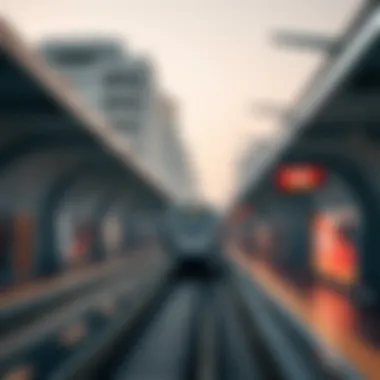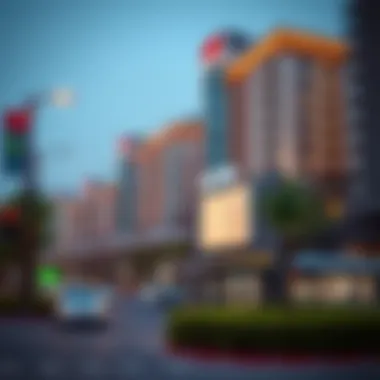Exploring Qusais Metro: Dubai's Transportation Hub


Intro
As cities evolve, their transportation systems play a crucial role in shaping urban landscapes and enabling seamless connectivity. In Dubai, one such critical transportation infrastructure is the Qusais Metro route, which stands as a testament to the city's commitment to modernizing public transit. Not only does it facilitate smooth movement within the bustling metropolis, but it also holds significant implications for property investment, real estate dynamics, and economic growth.
This piece sets out to provide a panoramic view of the Qusais Metro, exploring everything from its historical significance, operational nuances, and how it influences the local real estate market. Whether you are an investor looking for opportunities or a resident aiming to understand the intricacies of your neighborhood, this article will serve as a valuable resource as you delve deeper into the context and relevance of this vital metro line.
Let’s embark on this comprehensive examination of Qusais Metro, which not only serves as a transportation hub but also as a key player in the ongoing evolution of Dubai’s urban fabric.
Understanding Qusais Metro
The Qusais Metro stands as a crucial artery in Dubai’s ever-evolving transportation network, and understanding its implications goes beyond just commuting. The metro system doesn’t merely facilitate movement; it influences urban planning, commerce, and real estate development in a city relentlessly pushing towards innovation and connectivity. For investors and expats alike, grasping the nuances of this hub opens up a wealth of opportunities and insights into the dynamics of Dubai's growth.
Historical Context
Historically, the Qusais area was primarily known for residential and commercial establishments but lacked cohesive transport links. The decision to include the Qusais Metro station in the Dubai Metro Line was a hallmark of the city's vision to modernize and expand public transport. The initial discussions about the metro concept began in the early 2000s, influenced by rapid urbanization and an increasing population.
The project gained traction as Dubai prepared for the 2020 World Expo, aiming to showcase its emergence as a global city. In this context, the Qusais Metro symbolizes more than just a transit option; it represents Dubai’s commitment to creating sustainable urban environments and enhancing quality of life for its residents.
As a centerpiece of historical evolution, the Qusais Metro also illustrates the shift towards integrated urban mobility solutions. It serves not only local commuters but also international visitors, providing seamless connectivity throughout the region.
Construction Milestones
The construction of Qusais Metro was marked by several pivotal milestones that reflect the ambitions behind Dubai’s transport infrastructure.
- Ground-Breaking Ceremony: Initiated in 2006, the groundbreaking marked the starting point of numerous engineering feats. The project enlisted a multitude of contractors to meet its ambitious timelines.
- Completion of the Civil Works: By 2008, significant progress was made with the completion of the civil works, which entailed complex tunneling operations through varied geological conditions. Despite challenges, the dedication of the workforce resulted in keeping the project on schedule.
- Testing Phases: Before opening to the public in 2010, an extensive testing phase was conducted to ensure safety and operational efficiency. These tests confirmed the metro's stability and viability under real-world conditions, ensuring that the Qusais Metro would deliver a seamless ride for everyday users.
The construction journey of the Qusais Metro highlights determination and strategic planning, transforming the way residents navigate the bustling Dubai landscape. Seeing the metro come to fruition reaffirms the commitment of the Dubai government and its partners towards smart urban development.
By examining these distinct phases, one can appreciate the challenges faced and the innovative solutions deployed in constructing a state-of-the-art metro system that caters to the needs of a cosmopolitan populace.
Geographical Significance
The geographic positioning of the Qusais Metro in Dubai plays a pivotal role in its integration into the broader transport landscape of the city. Understanding this significance is essential as it sets the tone for how the metro interacts with various urban elements, enhancing accessibility and impacting economic activities in the region. With its strategic location, Qusais Metro is designed to not only serve residents but also to connect them seamlessly to vital commercial hubs and recreational areas, cultivating a dynamic urban environment.
Location Overview
Positioned in the northeastern sector of Dubai, the Qusais Metro serves as a crucial link within the public transit system. It nestles into an area that is sharply focused on being residential and commercial, providing residents a quick transit option to the city’s central districts. The convenient location enables easy access to essential services, schools, and shopping centers. Moreover, being situated close to major road networks and highways, it enhances the connectivity for both public transport users and private vehicle owners.
Key Surrounding Areas
Residential Zones
The residential zones surrounding the Qusais Metro offer a variety of accommodation types, catering to diverse demographics. One standout characteristic of these zones is the availability of family-friendly housing, featuring parks and schools nearby, making it an attractive option for families moving into the area. A unique feature of these residential areas is the burgeoning community feel, with residents often engaging in local events and activities, which fosters a sense of belonging and stability. However, with ongoing development, potential challenges arise such as increased traffic congestion during peak hours, which could impact the overall living experience.


Commercial Districts
Nearby commercial districts bring a vibrant energy to the Qusais Metro experience. These areas are characterized by a blend of shopping malls, offices, and eateries, providing residents and commuters with a lively atmosphere. The proximity to such commercial hotspots turns the metro station into a hub of activity, where opportunities for employment flourish. However, as the area continues to evolve, there is a risk of saturating the market, which may lead to intense competition among local businesses, compelling them to innovate to survive in a crowded space.
Transportation Links
When discussing transportation links, the Qusais Metro's interconnectivity with other transit systems becomes apparent. Its direct access to bus routes and proximity to major roads enhances the commuting experience, allowing for ease of transfers between modes of transport. This seamless integration is an essential feature, as it encourages public transport usage and reduces dependence on personal vehicles. However, the potential for overcrowding during peak transit times creates a disadvantage, stressing the need for consistent management of schedules and services.
The Qusais Metro’s geographical footprint highlights its critical role in promoting efficient urban mobility in Dubai, ultimately enhancing the way residents and visitors experience the city.
Operational Features
The operational features of the Qusais Metro are vital in understanding how this transportation hub integrates into the lives of Dubai's residents and visitors. These features not only highlight the technological advancements of the metro system but also its efficiency and the changes it brings to urban mobility. Delving into the aspects such as metro line specifications, frequency of service, and ticketing and fares offers insights into why Qusais Metro is a cornerstone of Dubai's transit framework.
Metro Line Specifications
At its core, the Qusais Metro operates on a specific set of specifications that define its functionality. The metro lines are designed to accommodate a heavy flow of passengers, ensuring that the system can handle the demands of a bustling city like Dubai. The Qusais Metro runs on the Red Line, which is a part of the expansive Dubai Metro network, spanning approximately 52 kilometers with numerous stations.
Key specifications include:
- Multiple train cars: Each train consists of several cars, allowing for a higher passenger capacity.
- Automated systems: The trains utilize advanced technology for automation, reducing the need for manual operation.
- Safety features: Incorporating various safety protocols such as fire alarm systems, emergency exits, and surveillance ensures passenger security.
These lines are not just about getting from point A to B; they're engineered to offer comfort and safety, making daily commutes smoother for everyone.
Frequency of Service
The timing of service is another critical aspect of operational features. Trains run with remarkable frequency, which is a necessity for a city that does not sleep. During peak times, trains can arrive as frequently as every three to five minutes, and during off-peak hours, the wait is typically no longer than ten minutes. This consistent schedule is crucial for maintaining the flow of passengers, allowing commuters to effectively plan their journeys.
Furthermore, the operational hours are designed to cater to both early risers and night owls, generally running from 6 AM to midnight on weekdays and extended hours on weekends. This flexibility ensures that whether someone is commuting to work, attending events, or simply exploring the city, the metro provides a reliable option.
Ticketing and Fares
Understanding the ticketing system is important for optimizing the experience of using the metro. Qusais Metro operates on a smart card system known as the NOL card, which serves as the primary method for fare collection. The NOL card offers a convenient way to manage travel costs while providing the flexibility to travel across different modes of public transport in Dubai.
The fare structure is tiered, based on the distance traveled. Passengers can expect to pay a nominal fee that reflects the distance, making it a cost-effective solution for getting around the city. The passes come in various forms, including:
- Red Ticket: Suitable for short trips and visitors, valid for a limited number of journeys.
- Silver NOL Card: Ideal for residents and frequent travelers, allowing multiple uses and top-ups.
- Gold NOL Card: Offers premium experiences with access to first-class cabins in the metro.
Using these cards not only streamlines the experience but also encourages the use of public transport, further reducing traffic congestion in the metropolis.
Overall, the operational features of the Qusais Metro underscore its role in enhancing mobility across Dubai. The specifications ensure a high capacity and safety for users, while the frequency of service shapes commuting habits. Finally, a user-friendly fare system makes regular travel accessible and appealing.
Qusais Metro and Economic Impact


The Qusais Metro is not just another cog in Dubai’s extensive transportation machinery. It plays a pivotal role in shaping the economic landscape of the area. By connecting neighborhoods, businesses, and vital commercial districts, it’s aptly placed to uplift local economies. The focus here will be on its impact on local businesses and its broader contribution to job creation.
Influence on Local Businesses
The arrival of the Qusais Metro has ushered in a significant wave of opportunity for local businesses. Connecting various commercial hubs, the metro serves as an arterial route, bringing foot traffic that can be a boon for many enterprises.
A few points to consider regarding its influence include:
- Accessibility: With the metro allowing easy access to surrounding areas, businesses near stations stand to benefit from increased exposure, often resulting in higher sales.
- Diversity of Offerings: The influx of new customers encourages establishments to diversify their products and services, catering to a broader audience.
- Property Values: As new businesses flourish, property values in the vicinity tend to spike. This can be a double-edged sword—while it’s good for property owners, it can lead to higher rents, forcing some businesses to relocate.
The presence of the metro has made it more feasible for entrepreneurs to start small businesses, creating a community of shops, cafes, and services that cater directly to metro users. This symbiotic relationship between the metro and local businesses helps fortify the economic fabric of the area.
"The impact of the Qusais Metro on local businesses is akin to dropping a pebble in a pond; the ripples of its influence can be felt far and wide."
Contribution to Job Creation
Job creation is another essential aspect of Qusais Metro's economic impact. The construction phase alone created thousands of jobs, spanning various sectors, from engineering to skilled labor. Now that the metro is operational, it continues to foster job opportunities in different ways:
- Employment within the System: The metro relies on staff to operate, maintain, and manage services, creating numerous jobs in the long run.
- Support Industries: Beyond direct employment, the metro supports a myriad of related industries, from marketing agencies to mobile food vendors, all of which thrive on the traffic the system generates.
- Economic Catalysts: By enhancing accessibility and mobility, the metro catalyzes further investment in the area, leading to new enterprises and initiatives, thereby generating even more employment opportunities.
The Qusais Metro acts not only as a transportation solution but also as a catalyst for economic growth and job creation, offering a tangible benefit that extends beyond just getting from point A to point B. The future seems bright as this vital component continues to evolve and spur growth in Dubai’s urban landscape.
Real Estate Dynamics
The Qusais Metro station is not just a pivotal point in the transportation network; it markedly influences the local real estate market. Its presence accentuates accessibility and connectivity, thus heightening interest in the adjacent properties. In an era where location is everything, the proximity to a metro station like Qusais places residential and commercial properties in the spotlight, enhancing their desirability among investors and potential buyers alike. The dynamics at play here reveal how transportation infrastructure can sculpt the landscape of urban development.
Property Values
Property values near the Qusais Metro have seen noticeable fluctuations as interest in this region grows. With efficient public transport, properties tend to appreciate more consistently, reflecting the rising demand from both investors and new residents. The ability to live close to a public transport hub often significantly increases property desirability. This demand pushes up the prices, creating a vibrant market for both buying and renting.
Areas within a few minutes' walk from the Qusais Metro often boast higher rental yields compared to other regions in Dubai. For families and professionals alike, the promise of a seamless commute can justify a premium on property values. Therefore, those looking to invest should pay attention to developments around the Qusais Metro; they can potentially capitalize on rising trends that smartly leverage connectivity as a key selling point.
Investment Opportunities
Investment in Qusais is not just about residential properties; it branches into the realm of commercial assets as well. This makes it appealing for investors looking at diversified portfolios.
Residential Developments
Residential developments near the Qusais Metro station embody a prime opportunity for keen investors. These developments are often modern, equipped with necessary amenities and designed for convenience. The unique feature of these properties is their strategic location, which offers both privacy and easy access to urban life.
The continuous influx of expats and families searching for new homes means that residential units here are not just homes but also excellent investment vehicles. Buyers are often drawn to the promise of a vibrant community with nearby recreational facilities, schools, and medical services. However, potential buyers should also be wary of market saturation in some segments, impacting resale values. Balancing these factors is crucial for making informed investment choices in this dynamic landscape.
Commercial Properties


On the other hand, commercial properties in the vicinity of the Qusais Metro also present a prevailing investment opportunity. With a high footfall of commuters daily, businesses such as cafes, retail shops, and service providers thrive. The key characteristic of these commercial spaces is their visibility and accessibility, which can drive significant customer traffic.
Investors are quick to recognize that commercial leases typically offer longer terms than residential agreements, offering stability and predictability in income. And while the advantages here are clear, it’s also important to note that competition can be fierce, especially for premier locations.
In summary, the real estate dynamics surrounding Qusais Metro paint a promising picture. Real estate agents and investors, along with individuals looking to settle down, should keep a watchful eye on this area, as it could well reflect broader trends in Dubai's evolving urban narrative.
Challenges Faced
When discussing the Qusais Metro, one must make note of the challenges that have emerged alongside its development. Addressing these hiccups not only enhances our understanding of the logistical intricacies involved but also helps investors and stakeholders navigate potential pitfalls. With the demand for efficient public transport rising, recognizing these obstacles becomes pivotal to ensuring that the Qusais Metro achieves its full potential as a key transit artery in Dubai. Here’s a closer look at some pressing issues.
Infrastructure Limitations
The physical framework that supports the Qusais Metro is, without doubt, a critical piece of the puzzle. However, the existing infrastructure faces several constraints that populate discussions among city planners and residents alike.
- Capacity Constraints: One of the main issues is capacity. During peak hours, the metro system can feel more crowded than a can of sardines. This overwhelms the existing trains and stations, leading to long wait times and hasty commutes. Ultimately, accommodating the vast number of passengers is a heart-burning challenge that needs addressing.
- Aging Facilities: Parts of the infrastructure show wear and tear from consistent usage. The older stations might not meet modern safety or accessibility standards, making successful navigation for all passengers more than just a walk in the park. Upgrades and regular maintenance would be essential but come at a cost.
- Limited Connectivity: While Qusais Metro has established some valuable links, it continues to be critized for not connecting seamlessly with other transport modes such as buses or trams. This disjointed web restricts ease of transfers and frustrates commuters looking for a smooth journey across the city.
All these factors highlight that the infrastructure, as impressive as it might be, could use a fresh coat of paint and a few robust investments to ensure it serves the growing population of Dubai.
Environmental Concerns
The survival of our planet is a pressing concern, and public transport systems aren't off the hook either. Even well-meaning transit options like the Qusais Metro must wrestle with an array of environmental issues.
"Public transport can either be part of the solution to urban pollution or a part of the problem."
- Land Use Issues: The construction of metro lines often comes at the expense of green areas. As Qusais seeks to expand, some existing parks or natural habitats face threats, which can spark public outcry and political issues.
- Carbon Emissions: While utilizing a metro reduces cars on the road, the construction and maintenance of such systems carry their environmental footprints. Heavy machinery, concrete pouring, and rail laying all contribute to increased carbon emissions initially, a fact not everybody considers.
- Noise Pollution: While there’s no denying the Qusais Metro can reduce traffic congestion, its operation isn’t without sound. The noise generated from trains can interfere with daily life for nearby residents, making it a double-edged sword for urban planners trying to create a harmonious living environment.
In light of these concerns, future expansions must be carefully considered so that they align with sustainable practices. These considerations underscore necessary dialogues regarding urban development and environmental stewardship.
The End
The challenges faced by the Qusais Metro illustrate the complexity of sustaining an evolving urban transport network. Acknowledging and addressing infrastructure limitations and environmental considerations must remain central in discussions surrounding the Qusais Metro’s future. Only with a well-thought-out approach can Dubai maximize this transit hub's potential, benefiting both residents and investors.
Future Prospects
As we gaze into the horizon of Dubai's Qusais Metro, it becomes clear that the future prospects surrounding this transportation hub hold considerable promise, not just for the locality but for the broader urban fabric of the city itself. The ongoing evolution of this metro station signifies a pivotal movement towards a more connected and efficient megacity. In this section, we’ll explore the proposed expansions and the integration with other transportation modes that are set to redefine how residents and visitors traverse Dubai.
Proposed Expansions
Qusais Metro isn’t resting on its laurels. Expansion plans are already in the pipeline designed to enhance both capacity and service coverage. This will mean that the various neighborhoods located a little farther from current metro lines will gain improved access to the city’s transportation network. Potential expansions may include:
- Increased Number of Stations: New stations could spring up around areas like Mirdif and Dubai Silicon Oasis, serving a larger population of commuters and alleviating congestion on the existing lines.
- Extended Lines: Plans to extend the Red Line further into neighboring emirates could open up significant travel avenues. This is not just a logistical consideration; it also has implications for real estate and economic development.
Expansion will also provide direct benefits to businesses through increased foot traffic and accessibility. More intricate connections can bring tourists and residents alike to local shops and attractions, thus spurring economic growth.
Integration with Other Transportation Modes
The future of Qusais Metro is not limited to its expansion alone. A key element in its continued success is the integration with other transportation systems. Seamless connectivity between various modalities of transport is crucial for creating a holistic travel experience. Some aspects of this integration might include:
- Bus Networks: Enhanced synchronization with nearby bus routes can ensure that commuters experience minimal delays when transitioning between metro and bus systems.
- Ride-Sharing Services: The integration of ride-sharing options can provide last-mile connectivity, bridging the gap for travelers who may live too far to walk.
- Walking and Cycling Paths: An emphasis on pedestrian-friendly pathways and dedicated cycling paths will not only promote healthier commuting options but also increase overall accessibility.
Effective integration creates a comprehensive transport strategy that enables smooth movement throughout the city. This is essential for attracting both residents and tourists, further reinforcing Dubai's status as a key urban center.











